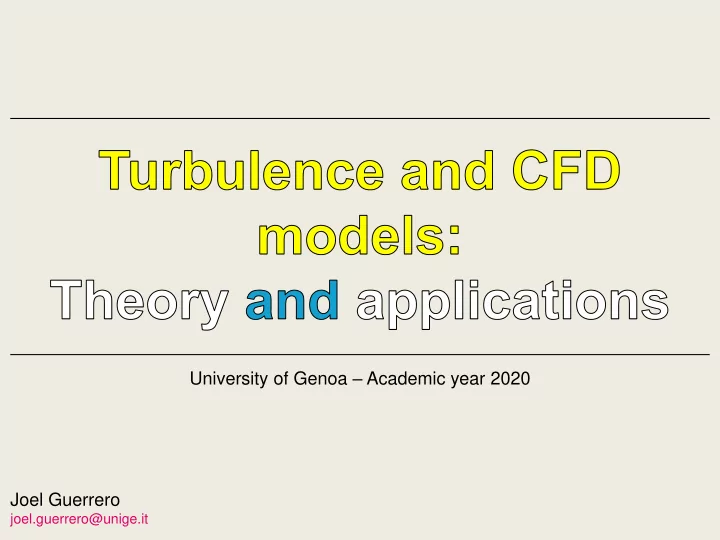

University of Genoa – Academic year 2020 Joel Guerrero joel.guerrero@unige.it
Photo by Ava W. on Unsplash
Our world is continuous
But the world of numerical simulations is discrete
Let us take a closer look to this pixelated area.
• In every single pixel (which we call control volume in numerical simulations) we solve the continuous governing equations of the physics of interest. • The process of solving the continuous governing equations in the world of numerical simulations (discrete world), is called discretization. • From the discretization process, truncation and modeling errors arise.
• Truncation errors are due to the dimension of the pixels (or control volumes). • The finer the pixelation is, the closer the numerical solution will be to the thought continuous solution. However, more pixels (or control volumes) translate in a higher computational cost.
• Modeling errors are due to the additional equations derived from the closure models introduced to approximate the governing equations. • These models include but are not limited to turbulence, multiphase flows, heat transfer and so on. • For example, when dealing with turbulence we usually use models because resolving all turbulence scales (in space and time), is extremely expensive. • The turbulence models (and all other models) are abstraction of the reality and are not exactly true. While deriving these models, many assumptions have been taken. • The models are used to make numerical simulations more affordable while preserving the accuracy. • Before using models, we should know the theory behind them, their range of applicability, limitations, and best standard practices. Solving the governing equations in the left figure is cheaper than solving the governing equations in the right figure. However, in the process of doing so, we are introducing truncation and modeling errors.
At this point, we need to find the approximated numerical solution of the continuous governing equations in every single pixel (or control volume) • In Computational Fluid Dynamics (CFD), we deal with the Navier-Stokes equations (NSE) plus additional closure models. Additional equations deriving from models, such as, multiphase flows, chemical reactions, turbulence modeling, combustion, multi-species, thermodynamics, volume fraction, and so on.
What is CFD? • Computational Fluid Dynamics (CFD), is the science of predicting fluid flow, heat and mass transfer, chemical reactions, and related phenomena by using numerical methods and computers. • To predict these phenomena, CFD finds the approximated numerical solution of the governing equations (conservation of mass, momentum, energy, and additional transport equations and models). • CFD is an ensemble of, • Numerical methods. • Computer science. • Fluid dynamics. • Scientific visualization. • Engineering applications. • And most recently, machine learning is making its way.
CFD and multiphysics simulations Multiphysics simulations • Multiphysics simulations (MS) are computer simulations that involve physical models or phenomena that can be coupled together. • MS consists in finding the approximated numerical solution of the governing equations (often PDEs). • The physics involved can be fluid flow, heat transfer, mass transfer, stress/deformation, structural dynamics, chemical kinetics, pharmacokinetics, biochemistry, electrostatics, electromagnetics, fire dynamics, aero- acoustics, combustion, chemical reactions, finance, astronomy, and others, coupled in any combination. • These disciplines can be solved in multiple dimensions, from 1D to 3D, and in steady or unsteady formulations. • I like to see CFD as a subset of Multiphysics simulations. • Multiphysics simulations can include the following computational disciplines: • → Computational fluid dynamics CFD • → Computational structural dynamics CSD • → Computational heat transfer CHT • → Computational electromagnetics CEM • → Computational aero-acoustics CAA • → Magneto hydrodynamics MHD • → Fluid structure interaction FSI • → Discrete particle methods DPM • And many more …
CFD and multiphysics simulations • In CFD and multiphysics simulations there are many discretization approaches, just to name a few: • → Finite Difference Method FDM • Finite Element Method – Galerkin → G-FEM • Finite Element Method – Discontinuous Galerkin → DG-FEM • → Finite Volume Method FVM • → Immersed Boundary Method IBM • → Discontinuous Galerkin DG • → Lattice Boltzmann Method LBM • → Spectral Element Methods SEM • → Boundary Element Method BEM • Each method will find the approximated numerical solution of the governing equations • The main difference among all methods is the way how they arrive to the system of discrete algebraic equations. • Most of the commercial Multiphysics frameworks and CFD solvers are based on the FVM. • Also, many open-source frameworks are based on the FVM. • The popularity of the FVM relies on the fact that can be used with arbitrary control volumes, it is easy to implement, and it enforces conservation in every single cell of the mesh (thus in the whole domain). • OpenFOAM, SU2, code Saturne, FUN3D, USM3D, CFDShip-Iowa, CFX, FLUENT, Star-CCM, NUMECA, and CFD-ACE+ (among many CFD solvers), are all based on the FVM.
• The main object of the course is to give you a thorough knowledge of turbulence modeling in CFD from the theoretical and practical points of view. • During the course, we will cover RANS models (Reynolds- Averaged Navier-Stokes) and scale-resolving simulations (SRS), such as LES and DES. • We will also address accuracy and reliability of CFD turbulent simulations. • We will cover discretization techniques, solution strategies, and best standard practices when conducting CFD simulations. • At the end, you should be able to give a critical assessment of the CFD simulations that you are conducting, independently of the software used.
“Essentially, all models are wrong, but some are useful” G. E. P. Box George Edward Pelham Box 18 October 1919 – 28 March 2013. Statistician, who worked in the areas of quality control, time-series analysis, design of experiments, and Bayesian inference. He has been called “one of the great statistical minds of the 20th century” .
Recommend
More recommend